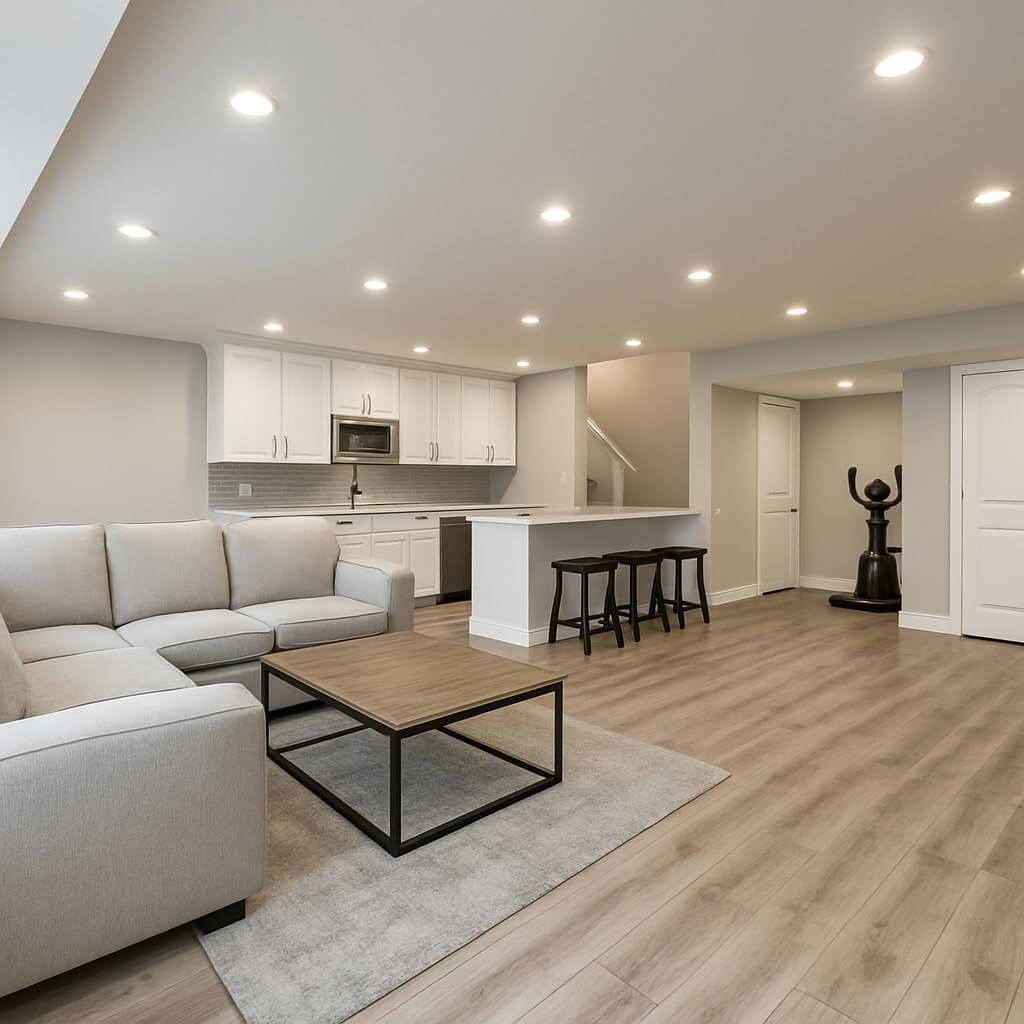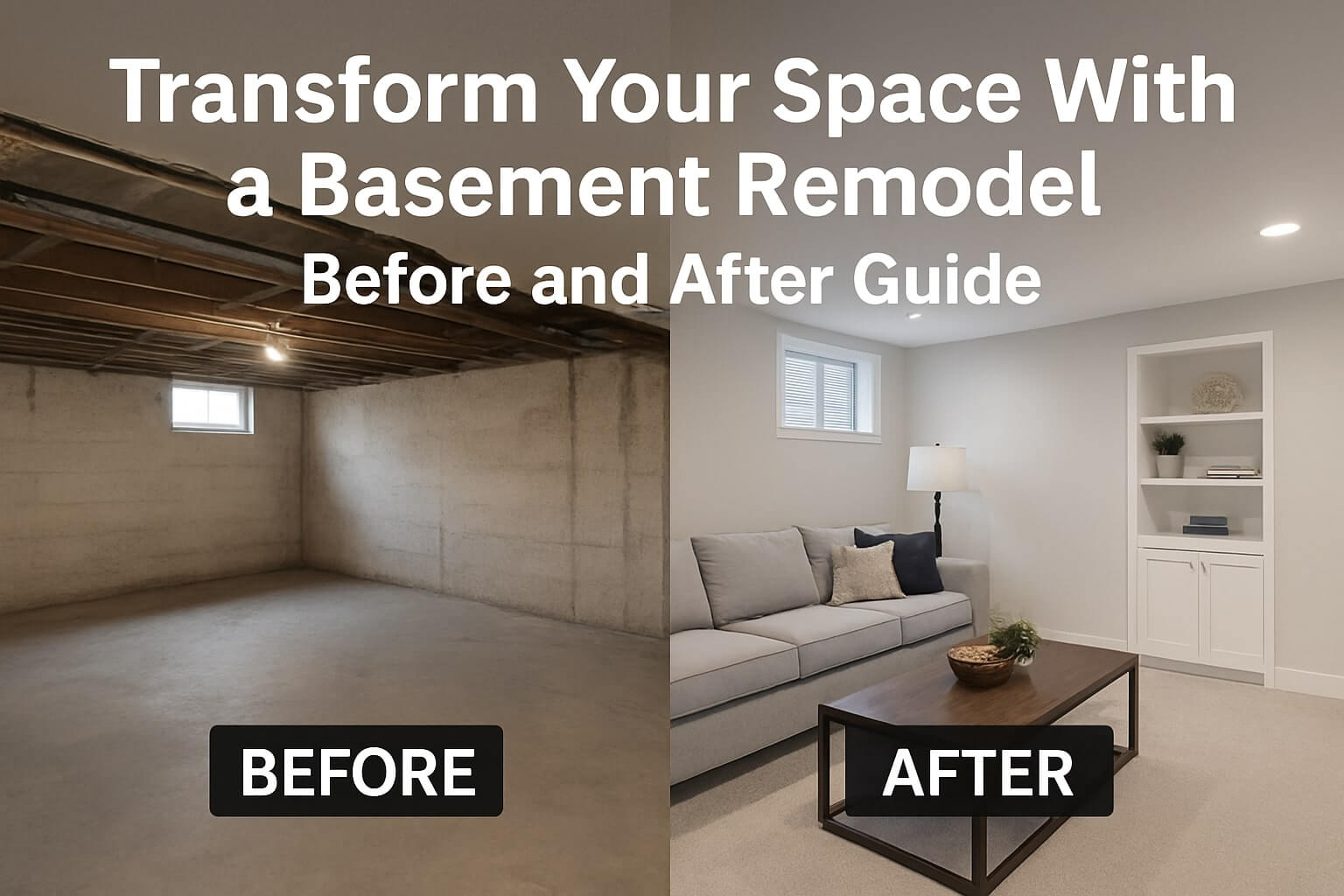When you decide to remodel your basement, it’s essential to approach the project methodically. Start by defining its purpose and setting a budget that fits your vision. Assess the space to understand what’s possible, then plan an efficient layout. Each step builds on the last, leading to a functional and inviting area. But there’s much more to reflect on as you navigate through the process, so let’s explore the key steps in detail.
Key Takeaways
- Define the purpose of the basement remodel, such as a family room, home office, or rental unit, to guide design choices.
- Set a realistic budget that includes all costs and allows for unexpected expenses to avoid overspending.
- Plan the layout carefully, considering natural light, storage solutions, and easy movement between areas for optimal functionality.
- Obtain necessary permits and ensure compliance with local regulations to avoid fines or delays during construction.
- Choose durable materials and finishes that align with your design vision while prioritizing functionality and comfort in the space.
Define Your Purpose and Goals

Before diving into your basement remodel, it’s essential to define your purpose and goals for the space. Purpose clarity helps you envision what you want the area to achieve—whether it’s a cozy family room, a home office, or a rental unit.
Once you’ve identified the purpose, focus on goal alignment; set specific, measurable objectives that guide your design choices. Ask yourself how the remodel will enhance your lifestyle or add value to your home.
Set a Budget
Setting a budget for your basement remodel is essential to keep the project on track.
Start by determining the overall costs, including materials and labor, then allocate some funds for unexpected expenses.
Finally, prioritize key features to guarantee that your budget aligns with your goals and vision for the space.
Determine Overall Costs
Establishing a budget for your basement remodel is essential to guarantee you don’t overspend and can manage your finances effectively.
Start with a cost estimation for materials, labor, and any permits required. Break down your budget into categories, like flooring, lighting, and plumbing, to create a clear budget breakdown. This will help you visualize where your money goes and identify areas where you can save.
Be realistic about your needs versus wants, ensuring you prioritize essential elements first. By knowing your overall costs upfront, you’ll set yourself up for a successful and satisfying basement transformation.
Allocate for Contingencies
While planning your basement remodel, it’s essential to allocate for contingencies in your budget.
An emergency fund helps you tackle unexpected expenses without derailing your project. Aim for 10-20% of your total budget for these potential costs.
Here are some common contingencies to take into account:
- Structural repairs
- Plumbing and electrical issues
- Water damage or mold remediation
- Additional permits or fees
- Upgraded materials due to unavailability
Prioritize Key Features
To create a successful basement remodel, it’s vital to prioritize key features that align with your vision and budget.
Start by considering your lighting options; well-placed fixtures can transform the space, making it feel inviting and functional.
Next, think about storage solutions—built-in shelves or cabinets can maximize space and keep clutter at bay.
List your must-haves and nice-to-haves, ensuring you allocate funds for these priorities first.
Remember, balancing aesthetics with practicality is important.
Assess the Space

Before you start your basement remodel, it’s essential to measure the available square footage to understand what you’re working with.
Take note of any structural limitations, like support beams or low ceilings, that could impact your design choices.
This assessment will help you plan effectively and make the most of your space.
Measure Available Square Footage
Measuring your basement’s available square footage is a crucial first step in the remodeling process.
Accurate measurements help you understand the space and enable effective space optimization. Use these measuring techniques to guarantee precision:
- Measure length and width of the area
- Note any obstructions like columns or ductwork
- Consider ceiling height for design options
- Account for windows and doors in your layout
- Create a scaled drawing of the basement
With these measurements, you’ll have a solid foundation to plan your remodel, making sure every square foot is utilized efficiently.
Start measuring, and watch your basement transform!
Identify Structural Limitations
While you’re excited about your basement remodel, it’s essential to identify any structural limitations that could impact your plans.
Start by inspecting load bearing walls, as altering or removing them may require professional assistance.
Check the ceiling height too; if it’s too low, you might need to contemplate raising the floor or adjusting your design.
Understanding these elements will help you create a functional space that meets local building codes.
Don’t overlook any potential issues—addressing them now will save you time and money later.
Your dream basement remodel starts with knowing what you can and can’t change!
Plan the Layout
As you commence your basement remodel, planning the layout is essential to maximizing the space’s functionality and aesthetic appeal.
A well-thought-out layout design can greatly enhance space optimization, ensuring every square foot serves a purpose.
Consider these key aspects:
- Define the primary function of each area.
- Incorporate natural light sources, like windows or light wells.
- Plan for adequate storage solutions.
- Choose furniture that complements the space without overcrowding.
- Create pathways for easy movement between areas.
With these points in mind, you’ll create a cohesive and inviting basement that meets your needs and reflects your style.
Obtain Necessary Permits

Before diving into your basement remodel, it’s essential to obtain the necessary permits, ensuring your project complies with local building codes.
Start by researching local regulations that apply to basement renovations. This may include electrical, plumbing, and structural changes.
Research local regulations for basement renovations, including electrical, plumbing, and structural changes, to ensure compliance.
Once you understand the requirements, complete your permit application accurately, providing all required documentation.
Don’t rush this step—failure to secure proper permits can lead to costly fines or project delays.
Contact your local building department for guidance and to clarify any questions you have.
Being proactive now will save you headaches later, paving the way for a successful remodel.
Address Moisture and Insulation
To create a comfortable and safe basement environment, you must address moisture and insulation issues right from the start.
Here are essential steps to take into account:
- Install moisture barriers along walls and floors to prevent water damage.
- Choose the right insulation types, like fiberglass or foam, to enhance energy efficiency.
- Guarantee proper ventilation to reduce humidity levels.
- Inspect for any leaks and repair them immediately.
- Use vapor barriers on the exterior of ducts and pipes to minimize condensation.
Install Electrical and Plumbing
Now that you’ve tackled moisture and insulation, it’s time to focus on installing electrical and plumbing systems.
Start by planning your electrical layout to guarantee you have sufficient outlets and lighting for your new space.
When it comes to plumbing, keep in mind the best practices for installation to avoid future issues and guarantee everything flows smoothly.
Plan Electrical Layout
As you plunge into your basement remodel, planning the electrical layout becomes essential for both safety and functionality. Adhering to electrical codes guarantees your space is safe and up to standard.
Consider these key elements:
- Identify outlets: Place them near workspaces and seating areas.
- Lighting design: Plan ambient, task, and accent lighting for versatility.
- Circuit capacity: Verify your system can handle additional devices.
- Switch locations: Position them conveniently for easy access.
- Future-proofing: Include extra outlets for potential upgrades.
With a well-thought-out electrical layout, you’ll create a basement that’s both practical and inviting.
Plumbing Installation Tips
While you’re getting your basement ready for a remodel, tackling plumbing installation is essential for both convenience and functionality. Start with careful plumbing materials selection; go for durable options like PEX or PVC. Next, focus on effective pipe routing techniques to guarantee proper drainage and accessibility.
Here’s a quick guide:
| Step | Tips |
|---|---|
| Materials Selection | Choose PEX or PVC for durability |
| Pipe Routing Techniques | Minimize bends for efficiency |
| Installation Check | Ensure proper slope for drainage |
Follow these tips, and you’ll set up a solid plumbing foundation for your basement remodel!
Choose Flooring and Wall Finishes

Choosing the right flooring and wall finishes is essential for creating a comfortable and inviting basement space.
Selecting appropriate flooring and wall finishes is crucial for transforming your basement into a warm and welcoming area.
You’ll want materials that are durable, moisture-resistant, and fit your style.
Consider these options:
- Vinyl options for easy maintenance and a variety of styles
- Carpet tiles for warmth and comfort
- Laminate flooring for a sleek, modern look
- Water-resistant paint colors to brighten up the walls
- Wood paneling for a cozy, rustic feel
Furnish and Decorate
Transforming your basement into a functional and inviting space requires thoughtful furnishing and decoration. Start with furniture selection that matches your intended use—consider cozy sofas for a family room or a sleek desk for a home office.
Don’t forget to choose pieces that fit the scale of your basement to guarantee a balanced look. Next, explore various decor styles, such as modern, rustic, or eclectic, to reflect your personality.
Incorporate decorative elements like rugs, wall art, and lighting to enhance the atmosphere. With the right furnishings and decor, you’ll create a space that’s both stylish and practical for everyday use.
Final Inspection and Enjoy Your New Space

After you’ve furnished and decorated your basement, it’s time for the final inspection to verify everything meets your expectations.
This final walkthrough is essential to guarantee quality and safety.
As you inspect your new space, remember to check:
- Electrical outlets and lighting
- Plumbing fixtures and drainage
- Wall finishes and flooring
- Windows and doors operation
- Ventilation and insulation
Once you’ve confirmed everything’s in order, it’s time to celebrate completion!
Gather friends and family to show off your stunning new basement. Enjoy the fruits of your labor and make unforgettable memories in your transformed space!
Conclusion
Now that you’ve navigated the essential steps for your basement remodel, it’s time to enjoy your newly transformed space! By clearly defining your goals, sticking to your budget, and carefully planning each phase, you’ve created an inviting area tailored to your needs. Don’t forget to celebrate your hard work—whether it’s a cozy family room or a stylish guest suite, your basement is ready to shine. Immerse yourself and make the most of your beautiful new environment!




